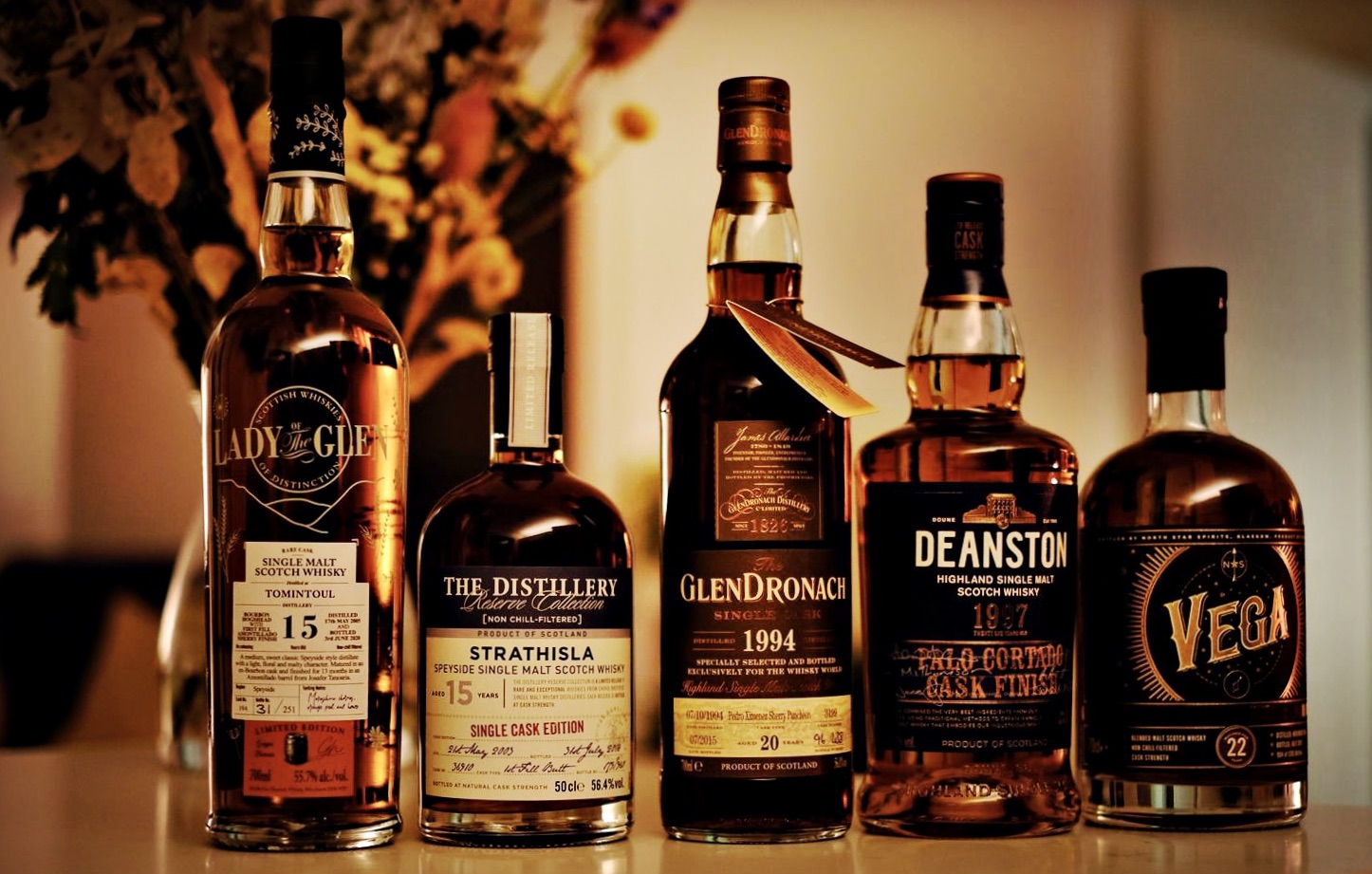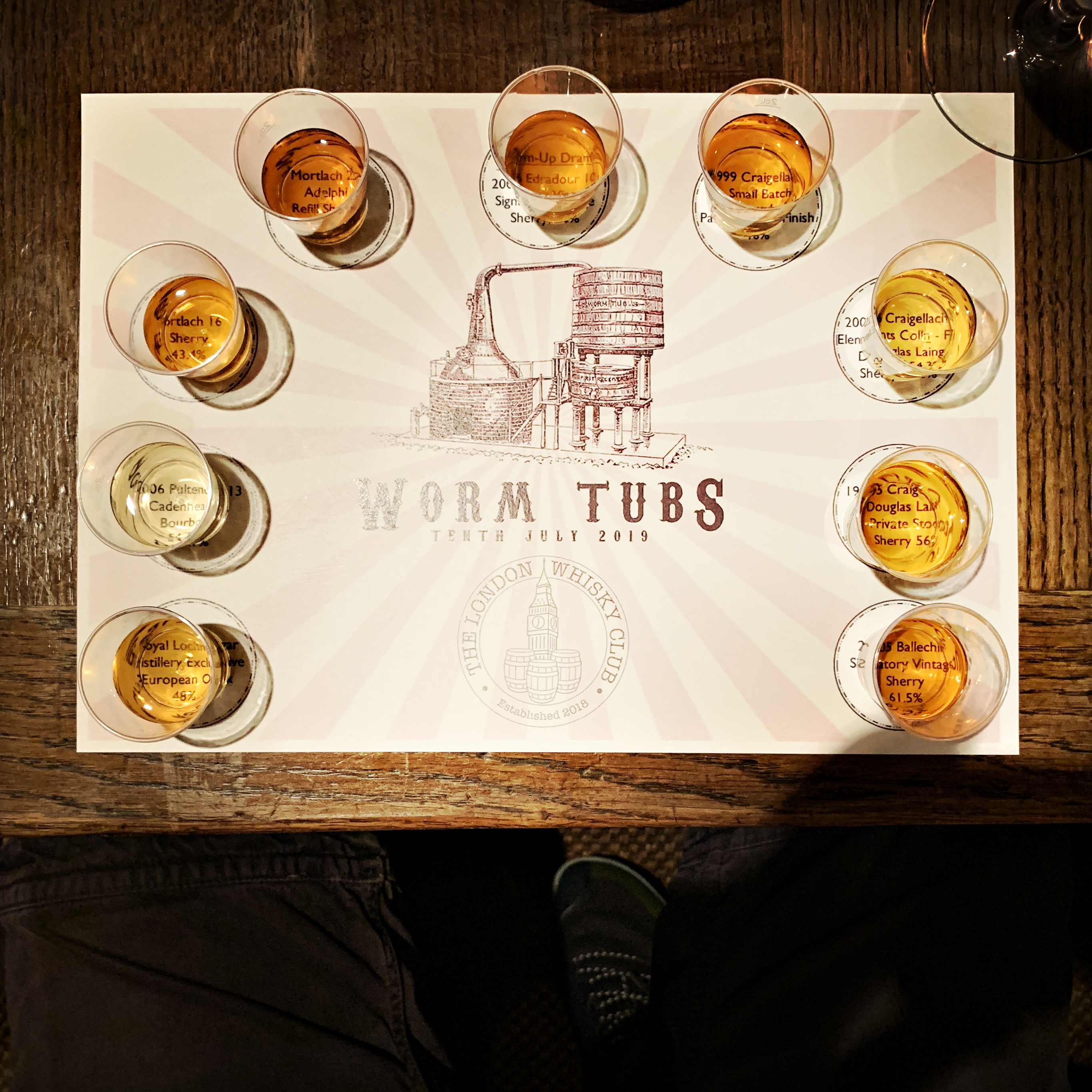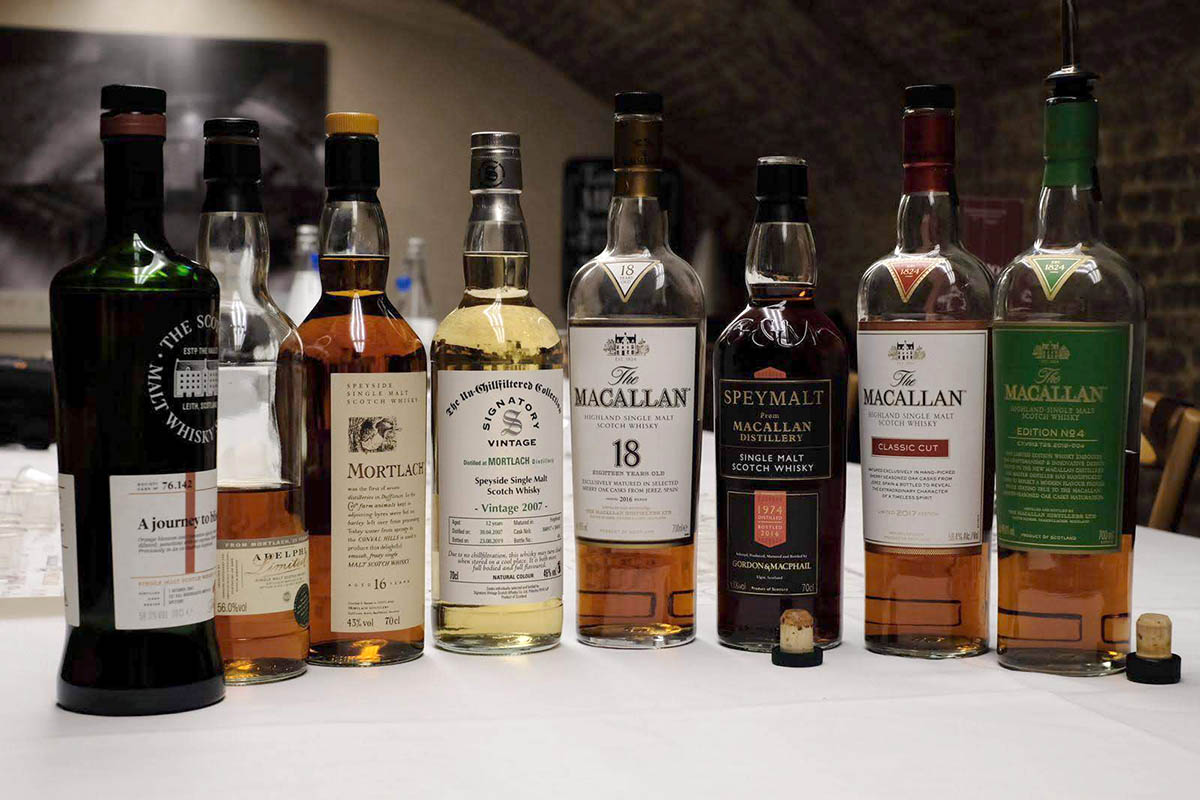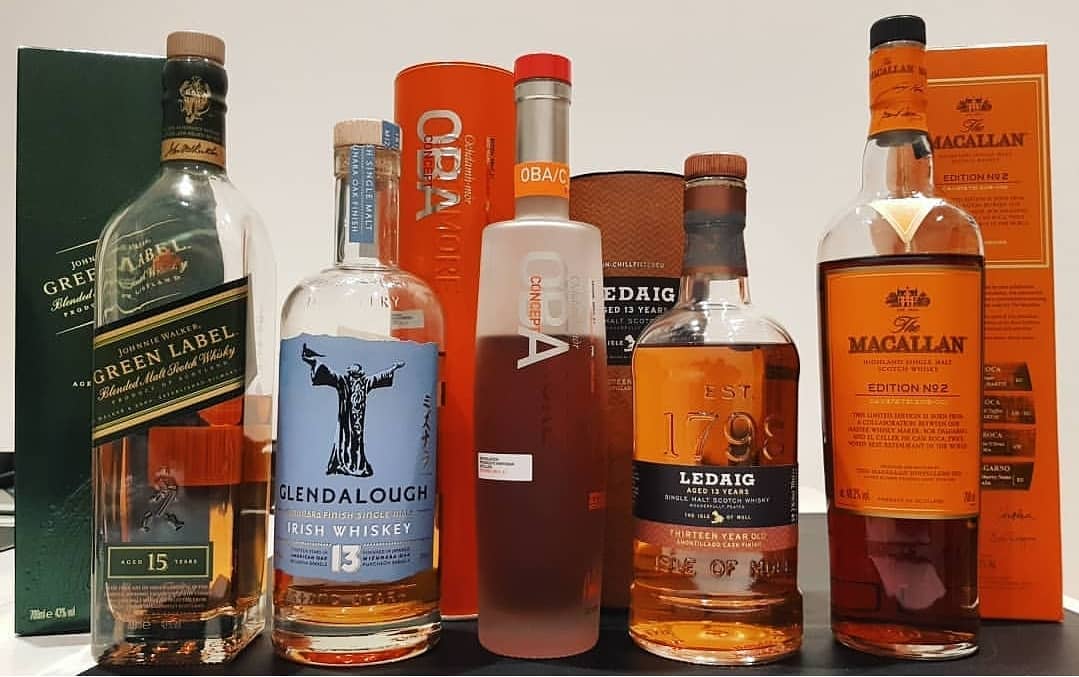Write up by Luke Jones…
This week’s tasting from TLWC is one a number of members have been looking forward to for quite some time… it’s the Sherry Armageddon hosted by the one and only, our very own Ian “@poshscotch” Robinson. TLWC members Sattu and Ian are big fans of sherried whisky; so much in fact that having canvassed repeatedly for a sherry-themed event, here it finally is. Tonight, Ian will walk us through four different types of sherry maturation, plus a blend.
Like Marmite, sherry matured whiskies split whisky drinkers. I for one am still not sold on it, and am yet to find an offering in this format that makes me think, “ah, so that’s why people love this so much”. There is, however, a large group of drinkers that swear by it. That is both what’s so great about whisky – there is something for everyone – and also why I’m looking forward to tonight, so I can finally find that bottle of sherried whisky that I can call the one.
What do we mean by sherried whisky? This is liquid which has been either fully matured in casks that previously held sherry, or whiskies matured in a more traditional cask e.g. ex-bourbon, then transferred into sherry cask for a period of finishing before being bottled.
To start to understand it in more detail, let’s start with what sherry actually is. It starts life as a dry white wine made from the Palomino grape, fortified and aged. The styles fall into two camps; first we have Fino, which has two further subsets in Manzanilla and Amontillado. The wine is lightly fortified, placed in butts of 500-700 litres and aged in a complex system known as a solera.
A thick, woolly blanket of yeast, flor, grows on the surface of the liquid, protecting the wine from the air. As a result the sherry is pale in colour with a light crisp character and aromas of almond, chalk, green olive plus, in Manzanilla’s case, a distinctly salty tang. If the flor is allowed to die then some oxidation takes place, the wine darkens in colour and becomes an Amontillado.
The second camp contains Oloroso and Palo Cortado. The same base wine is used, but is fortified to a higher strength; this additional alcohol kills the chances of flor growing (in the case of Palo Cortado the yeast-killing process happens by chance, rather than by design). Ageing again is done in a solera and after prolonged contact with the air the wines become darker and nuttier, with some dried fruit elements.
Pedro Ximénez (PX) – which is becoming increasingly used in Scotch maturation – is a separate style made from the eponymous grape. The grapes are dried in the sun to concentrate the sugars before being fermented, fortified and aged. This naturally sweet wine with a huge raisin impact is also used as a sweetening agent.
But why age, or finish whisky in sherry casks?
The Scots loved sherry and it has been drunk in Scotland from as early as 1548, but it was in the 18th century that it became a fashionable drink. Historically sherry would have been shipped to Glasgow and Leith in casks; this coincided with a dramatic expansion of the whisky industry. Given the lack of forests in Scotland to produce wood to use for casks, distillers turned to those casks arriving on the docks; these included rum and wine, as well as sherry, but it was the latter that became the preferred option.
It is estimated that up to 10 litres of sherry is soaked into the wood of a sherry butt, but the ‘sherried’ character is not solely because of the sherry itself; it’s also due to oxidation, and the way in which the sherry has changed compounds in the oak. All of these then interact over time with the maturing spirit.
A distiller wants a cask to contribute flavour to the maturing whisky: vanilla, coconut, spice and chocolate from American oak; tannin, resin, clove and dried fruits from European oak. Sherry butts are not made from active wood (usually old American oak casks), so the wood has little impact on the sherry; the taste of Fino is caused by the flor, the nuttiness of Oloroso by oxidation and the sweetness of PX by the ‘raisining’ effect.
In summary, in sherry wine production the flavours are driven by oxidation rather than by oak, while in the whisky maturation process, it is the other way around. To put it another way – on the one hand sherry producers want a cask which has little impact, while the Scots want the opposite.
Our exciting line-up for the night’s tasting:
- Vega 22yo Blended Malt, 43.9% ABV
- Deanston 1997 22yo Palo Cortado Finish, 51.8% ABV
- LoTG Tomintoul 15yo 1st fill Amontillado Finish, 55.7% ABV
- Strathisla 2003 15yo 1st fill Oloroso butt, 56.4% ABV
- Glendronach 1994 20yo PX Hogshead, 56.2% ABV

Vega 22y/o Blended Malt, 43.9% ABV
North Star is a Glasgow based indie who, in their own words, only bottle “the finest single malt scotch whisky, blended malt scotch whisky and blended scotch whisky”, all of which are small batch and always cask strength. Truth be told North Star have bottled some great whiskies over the years, so it will be good to try one that I have not had the pleasure of sampling before. Vega 22 is in its sixth edition and is a combination of whiskies distilled in 1996 and matured in a combination of European and American oak for 22 years, before being bottled in July 2019. This whisky has spent all its life in sherry casks before being vatted together; we don’t know which casks were used but given Oloroso tends to be the standard for blended sherry, it would appear we are getting more of the distillate flavours coming through, rather than cask influence. Guesses on the night suggested we could have some Glenfarclas here, given the age and price. There are only 1,205 bottles so perhaps only two casks were used, but given the level of angel’s share it’s more likely to be three.
Nose: Chocolate, tobacco and blackcurrant. Toasty cinnamon and black pepper, with a touch of earthy pine. Layers of dried fruit build after a few minutes in the glass.
Taste: Freshly ground coffee, chocolate orange and beef stock cubes. More tobacco and some nut. This is softly sherried, with enough spice to give it some heat. It’s balanced and not sweet with some grass and herbal notes.
Deanston 1997 22y/o Palo Cortado Finish, 51.8% ABV
Before we talk about the distillery and the whisky, a big thanks to George Brailey who provided this bottle from his own private stash.
Deanston is a single malt Scotch whisky distillery and the largest owned by whisky producer Distell Group Limited, who also own Bunnahabhain and Tobermory. Deanston started life in 1785 as a cotton mill and remained as such for 180 years until it was transformed into a distillery in 1966, the constant supply of pure water from the River Teith contributing to this decision. Deanston sits in the Highland region of Scotland and produces whisky that is handmade by ten local craftsmen, un-chill filtered and naturally coloured.
Whiskybase Serge and other popular reviewers have shown their influence on sales and prices recently; unfortunately, this bottle seems to have fallen to such a fate. It received a good rating, subsequently selling out very quickly, and is now one of only a few Deanstons that are more expensive on the resale market.
Nose: Honey, dried fruit, toffee, citrus, floral notes and oak. Toffee apples with milk chocolate and hazelnut pralines.
Taste: Honey and sweet dried fruit come through strong. Toffee with a hint of gentle spice and oak. There’s a creamy nuttiness coming through. It’s a little earthy and dry but a few drops of water has changed the texture, added more cream and made this less dry.
LoTG Tomintoul 15y/o 1st fill Amontillado Finish, 55.7% ABV
Lady of the Glen is an indie bottler focusing on a more premium single cask range. The Tomintoul-Glenlivet Distillery is in the Speyside region, and was founded in 1964; in 1974 it doubled its capacity when two extra stills were installed with which they now produce a range of single malts of different ages, a peated malt, and a vintage malt. Fun fact time: in 2009 Tomintoul entered the Guinness Book of World Records by producing the largest bottle of whisky in the world, containing 105.3 litres of 14 year old Tomintoul malt whisky! When the distillery was sold off to Angus Dundee in 2000, the 10y/o became their official bottling. The OB portfolio expanded over the next few years, with the introduction of a 16y/o in 2003 and a 27y/o in 2004. A year later a 1991 peaty vintage was released under the name ‘Old Ballantruan’, bottled at 50% ABV, shortly followed by a 12yo finished in Oloroso butts, a vatting of unpeated and peated Tomintoul named ‘Peaty Tang’ and a 1976 vintage – all released around 2008.
The whisky tonight is atypical for the distillery given they mostly use ex-bourbon casks, and furthermore Amontillado is a rare sherry cask. Amontillado is characterised by being darker than Fino but lighter than Oloroso; it is named after the Montilla region of Spain and is known by its nutty aromas, tobacco, aromatic herbs and often ethereal, polished notes of oak.
Nose: Deep and rich with notes of leather, autumnal fruit and coffee. Raisin, orange peel, nutty, peanut brittle, burnt butter and toffee.
Taste: Maraschino cherries, chocolate and honey. Oak tannins and treacle toffee. Light bodied and silky on the palate with lots of fruit and nuts, raisins and spices. This is a nice complex whisky with layers and developing flavours. Mint humbugs, roasted almonds and toffee fudge.
Strathisla 2003 15y/o 1st fill oloroso butt, 56.4% ABV
Strathisla distillery is the oldest continuously operating distillery in the Scottish Highlands. It was founded as the Milltown Distillery by George Taylor and Alexander Milne in 1786; in 1879 it was severely damaged by a fire, but was rebuilt and included a bottling plant during the rebuild. The distillery was acquired by current owners, Chivas Brothers Ltd in 1950.
Tonight’s bottle was distilled in 2003 and has been matured in a single first-fill butt, before being bottled in July 2018 for the Strathisla’s Distillery Reserve Collection. It’s our first full maturation of the night and given the cask type is not stated, it’s more than likely to be an Oloroso.
Nose: Tobacco, Tipp-ex and resin with rhubarb crumble and stewed apples. A very autumnal dram. Water adds plasters and plasticine and some wax.
Taste: Rubber and tobacco, you can almost chew it on the palate. The burnt sugar on the top of creme brûlée and fresh orange juice. Its getting sweeter and syrupy with almost an artificial fruit note.
Glendronach 1994 20y/o PX Hogshead, 56.2% ABV
Nose: Spiced sherry-poached pears with a deep, leathery character. Freshly opened bag of raisins. Sour cream or maybe warm milk. Spicy and slightly greasy as Glendronach usually is, with a big helping of dust, leather and old books. Some dark chilli chocolate.
Taste: Dark chocolate covered rum raisins, treacle and herbal oak spices. Red apples, leather and not overly px body. Tannic but velvety with fresh plums. Chocolate covered fruitcake and crystallised ginger.
DRAM OF THE NIGHT
This was a close one, more so than it’s been for quite some time. The Glendronach came out on top but only a few votes separated it from Tomintoul in second place and Deanston in third. Unfortunately the Vega was a firm last and didn’t get any love at all but, while the Strathisla came in fourth, this was more down to the strength of the top three than a lack of appreciation.
———————————————————————
The next club tasting is another fans’ favourite… it’s the charity Chichibu tasting with @thewhiskybarrista. Given the scarcity of these bottles the tasting is limited to only 17 places, with the lucky individuals being selected by ballot and all proceeds going to charity. To the fortunate few, see you on Wednesday 28th October.




